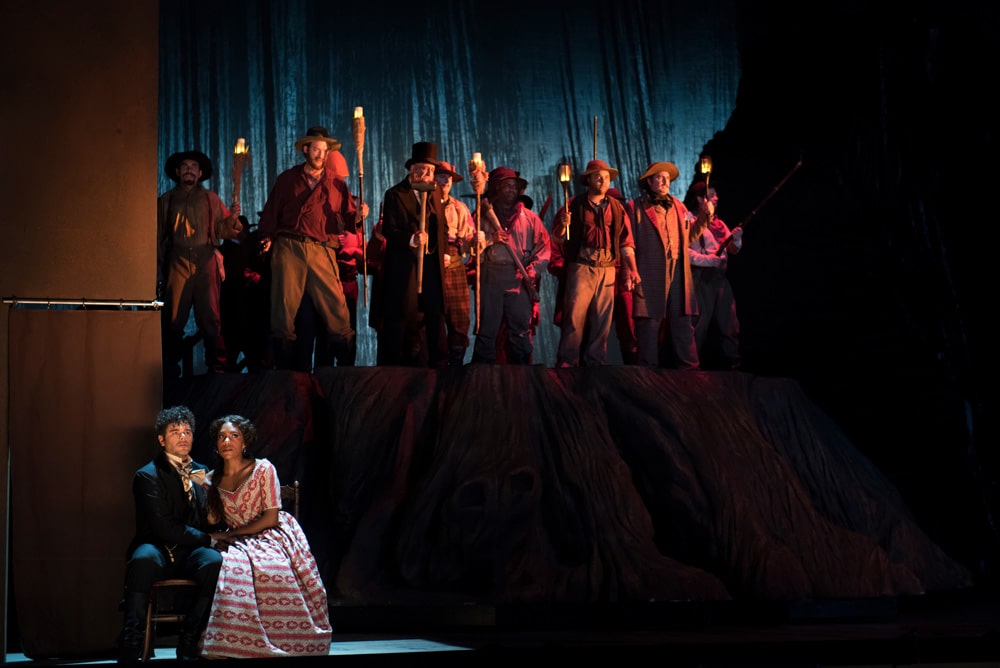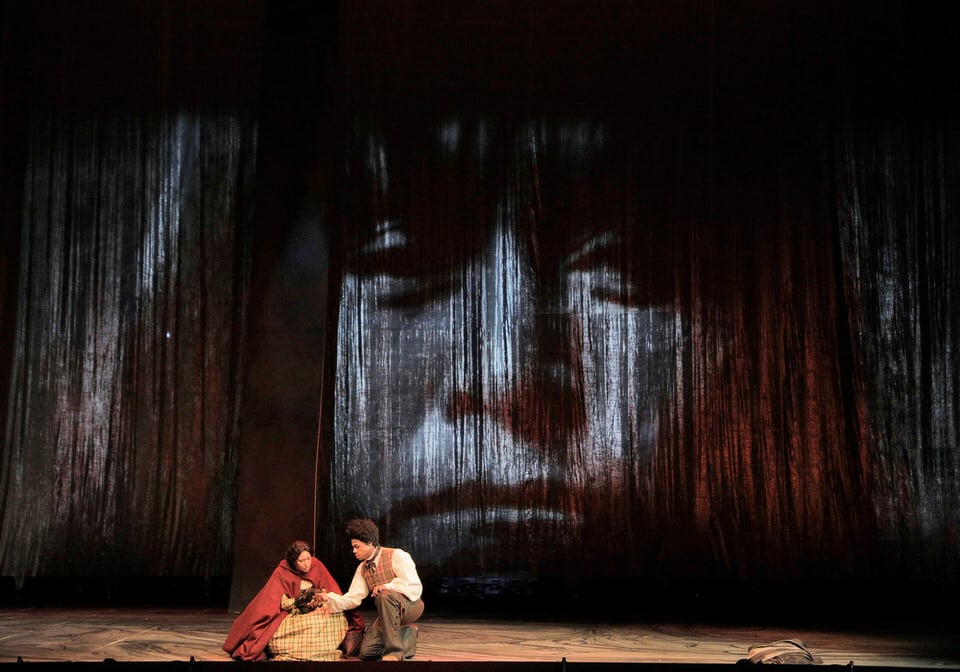The new John Adams opera “Girls of the Golden West” depicts the Gold Rush, an iconic moment in California history when people of different backgrounds suddenly came to live in the same place. With Adams, director Peter Sellars constructed much of the libretto from the letters of Louise Clappe, an educated woman who wrote under the pen name Dame Shirley while living in San Francisco and the Feather River mining communities. She is the opera’s central character; along with her are Ned Peters, a fugitive slave; and miners, barkeeps, and prostitutes of different races and ethnicities.I attended the second performance at San Francisco Opera, and spoke to a handful of audience members during and after the show.
Julius (a composer): SF Opera overdoes their staging to an ungodly amount. “Let’s carry the bed onto the stage, leave it there for about 45 seconds, and then have two new people walk on and carry it off.”
Katherine (a humanities graduate student): I liked the sets. I thought they were minimal but very effective; a few pieces of staging did a lot of work. I really liked the bar scene, and the moving panorama—that was actually a popular technology of the 19th century.
Julius: The music is more nostalgic than what I expected; it almost feels like it’s out of Adams’s mid-90s style, rather than his more recent language in things like Scheherazade.2.
Soo (a music educator): The music is great; it’s typical John Adams.

Julius: I think his comments about it being a simpler language for a simpler people are intriguing, and I think that’s reflected very clearly in what he’s done.
Soo: The last aria [in the first act] is so deep, and he sure knows how to build a climax with the orchestra.
Katherine: I would never listen to the music when I wasn’t watching the opera, I’ll say that. I’m not that into John Adams, generally—I don’t know what it is, but I don’t particularly like it. It wasn’t memorable.
Michaela (a string player): After the opera, I came out and a guy was singing “O Holy Night,” and that’s what was going through my head—nothing from the opera.
Katherine: I thought the main two women were such good singers that I enjoyed listening to them, even if I didn’t enjoy the music.
Michaela: The singers were all good, especially Ned [Davóne Tines]. I feel sorry for the singers who had to work with this score, but they seemed game.
Shiri (a retired medical worker): I liked watching the young lady adjusting to the minimalist nature of life in the mines.
Julius: It feels very open and honest to me, like a very beautiful look at humanity. I think Act I is a series of character studies, looking at these people and why they do the things that they do.

Katherine: There were so many threads, I don’t know how successful it was. Particularly in Act II, there wasn’t an emotional attachment to these characters to make you care about what was happening. The deaths didn’t really affect me. It was just like, “OK, now people are getting killed.” I thought Josefa’s husband was pointless: Is he dead, is he alive? I don’t really care either way.
Julius: I liked Act I well enough, but Act II had me in tears; it was simultaneously hard to watch and impossible to look away.
Soo: The social issues are what I like most about it, how issues of race, gender and sexism and all that come in.
Katherine: On the one hand I thought, “Well, it’s always good to be reminded”—but they really throw it in your face. It seemed completely overwrought: the red solo cups, the tiki torches.

Michaela: I thought it was really good having [contemporary references] in an opera.
Katherine: I wished I knew how the people around me were feeling about it. Were they taking it in and agreeing with it? I was getting the sense, and I don’t know if it was just me projecting, that a good number of the people in the audience didn’t want to think about these things. The way people were shifting in their seats—there were certain moments in the action, very overblown, like, “White people, you did wrong!” I think people in the audience were made uncomfortable by that.
Michaela: A lot of people walked out, but then again I went to “Walküre” once, and a lot of people left before the last act, which has the most famous part!
Ray (a technology product manager): I winced at several moments during the show because of the use of racial stereotypes of Native Americans and other people of color, specifically around physical appearance.
Katherine: Most of the libretto is based on one woman’s diary—she’s white, of course—and we see all the characters through her eyes. The one line that really moved me, that actually made me feel something, was Ned’s: “It is not light we need, but fire.” [That line is from a Frederick Douglass speech.]

Ray: The piece’s female characters (besides the protagonist) were decidedly wooden and reproduced the endemic misogyny of the time. Another example of providing a one-dimensional facsimile of historical material instead of engaging with it thoughtfully and constructing a dialogue between past and present.
Julius: The historical model has worked well in the past, for me at least. I think that “El Niño” and “Doctor Atomic” and “A Flowering Tree” were all fantastic pieces. I think there’s always resistance to something that’s new, something that’s done differently, and I understand that resistance, but I don’t think that’s a reason to condemn it.
Soo: I think his goal is to give a voice to people who didn’t have a voice, and in Dame Shirley being the narrator—well, it’s surprising to have the narrator be a woman, in a story about the Gold Rush!
Katherine: It’s simplistic. We have a miner’s town where the only women are prostitutes; we have these Chinese men who are alluded to, but not really fleshed out; we have these mulattos—but no black people. There’s not a lot of detail.
Julius: It’s not like we have texts by prostitutes during the Gold Rush time, I would guess. I’d certainly be curious to see more research, but it doesn’t bother me.

Ray: The characterizations may have been direct quotes, but they were delivered flatly, even with a touch of humor, as if there were nothing anachronistic or odd about them.
Soo: Given the text, they did a really good job with the music and the staging to say that Dame Shirley’s perspective wasn’t necessarily the perspective that the opera took; they pointed out that she was a bit parochial or typical of an upper-class woman at that time.
Ray: It comes as little surprise that the show is the work of an older white man. We need opera that is more ambitious, thinks bigger, and does better.
Katherine: I mean, Trump is president; we’re basically in neo-fascist times. I think art should try to respond to this if it wants to. It’s an admirable goal.
Patricia (a retired musician): SF Opera hasn’t brought back other Adams operas, yet. If you’re around in 30 or 40 years, it would be interesting to see what they’re still performing. ¶

